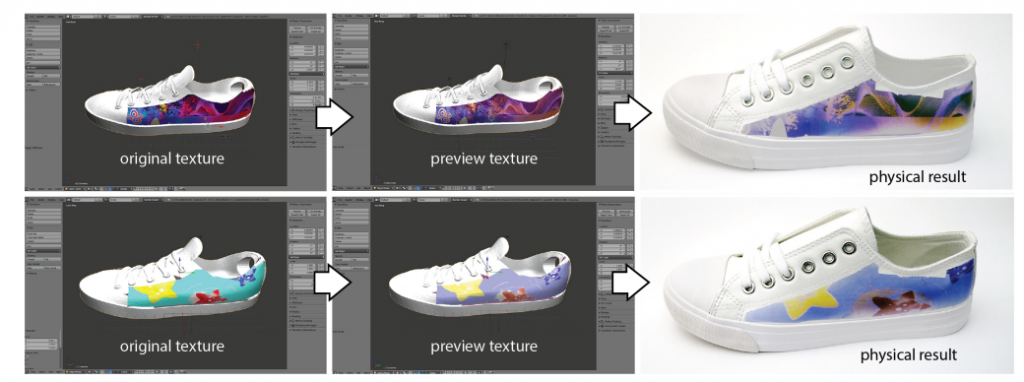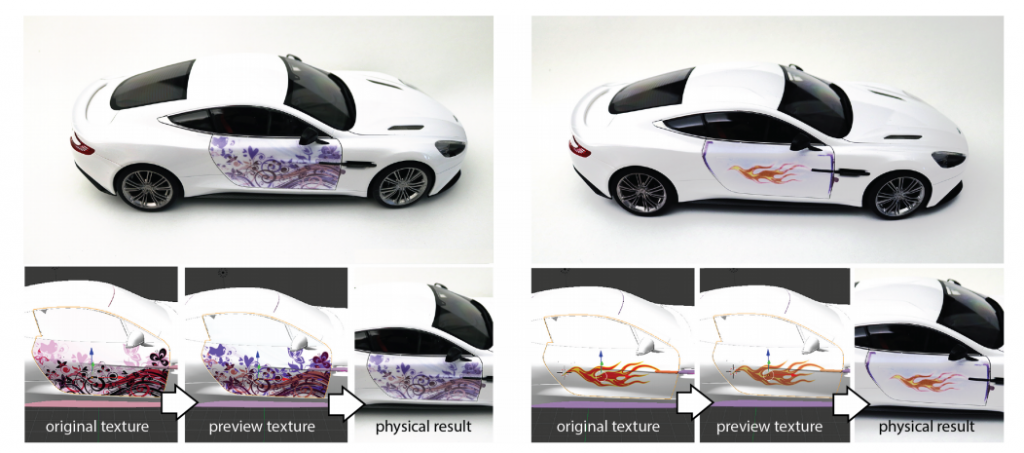Once again, scientists are inspired by nature in their work, and here—intensely so. Authors Yuhua Jin, Isabel Qamar, Michael Wessely, Aradhana Adhikari, Katarina Bulovic, Parinya Punpongsanon, and Stefanie Mueller explain their latest work in ‘Photo-Chromeleon: Re-Programmable Multi-Color Textures Using Photochromic Dyes.’
As the fascination of the chameleon continues throughout the ages, no one has ever been able to replicate the magic of their color-changing skin. MIT’s Computer Science and Artificial Intelligence Laboratory team, however, is applying a touch of this phenomenon to their latest 3D printing endeavors, creating a reprogrammable ink that changes colors upon exposure to UV and other light sources. The PhotoChromeleon system is made up of numerous dyes sprayed onto an object’s surface—allowing it to change color as needed.
“By mixing cyan, magenta, and yellow (CMY) photochromic dyes into a single solution and leveraging the different absorption spectra of each dye, we can control each color channel in the solution separately,” state the authors. “Our approach can transform single-material fabrication techniques, such as coating, into high-resolution multi-color processes.”

We can create re-programmable multi-color textures from a single material. (a) We mixed CMY photochromic dyes together to create our multi-color ink. (b) After coating the object, we use (c) a UV light source and a projector to control each color channel on a pixel-by-pixel basis, resulting in high-resolution multicolor textures that can be reapplied multiple times.
The potential for customization is exciting, allowing for use not only in natural environments (where the color remains after being applied due to its bi-stable nature), but also other applications like paint for cars, phone cases, and even fashion items like shoes.
“This special type of dye could enable a whole myriad of customization options that could improve manufacturing efficiency and reduce overall waste,” says CSAIL postdoc Yuhua Jin, and lead author. “Users could personalize their belongings and appearance on a daily basis, without the need to buy the same object multiple times in different colors and styles.”
Progressing from the last ColorMod system, the PhotoChromeleon ink allows users to create complex patterns and even ‘sweeping landscape’ in multiple colors. A user interface creates designs and patterns, and then the program transfers it to the object. Once an object is coated and then put under UV light, colors range from transparent to ‘full saturation,’ and can be desaturated as desired, with the whole process for the user taking from 15 to 40 minutes. Designs can also be easily erased with the UV light.
“By giving users the autonomy to individualize their items, countless resources could be preserved, and the opportunities to creatively change your favorite possessions are boundless,” says MIT professor Stefanie Mueller.
Currently, there are still some limits in the range of color, and in some cases the researchers must settle for just getting as close to a specific hue as possible; they do, however, plan to work with materials scientists to complete the entire color palette.
“We believe incorporation of novel, multi-photochromic inks into traditional materials can add value to Ford products by reducing the cost and time required for fabricating automotive parts,” says Dr. Alper Kiziltas, Technical Specialist of Sustainable and Emerging Materials at Ford. “This ink could reduce the number of steps required for producing a multicolor part or improve the durability of the color from weathering or UV degradation. One day, we might even be able to personalize our vehicles on a whim.”
Jin co-authored the paper with CSAIL postdocs Isabel Qamar and Michael Wessely. Former MIT UROP students Aradhana Adhikari and Katarina Bulovic contributed as well as MIT alum and current Assistant Professor in engineering at Osaka University Parinya Punpongsanon, and Stefanie Mueller.
Former MIT UROP student Aradhana Adhikari received the Morais and Rosenblum Best UROP Award for her contributions to the project.
While this is a complex and useful system with potential for use for 3D printing enthusiasts around the world, nature as an inspiration has been noted in a variety a projects from fabrication of conductive parts to recyclable liquid polymers, replication of other complex structures, and more. What do you think of this news? Let us know your thoughts! Join the discussion of this and other 3D printing topics at 3DPrintBoard.com.
[Source / Images: CSAIL MIT]Subscribe to Our Email Newsletter
Stay up-to-date on all the latest news from the 3D printing industry and receive information and offers from third party vendors.
You May Also Like
3D Printing Unpeeled: New Arkema Material for HP, Saddle and Macro MEMS
A new Arkema material for MJF is said to reduce costs per part by up to 25% and have an 85% reusability ratio. HP 3D HR PA 12 S has been...
3D Printing News Briefs, January 20, 2024: FDM, LPBF, Underwater 3D Printer, Racing, & More
We’re starting off with a process certification in today’s 3D Printing News Briefs, and then moving on to research about solute trapping, laser powder bed fusion, and then moving on...
3D Printing Webinar and Event Roundup: December 3, 2023
We’ve got plenty of events and webinars coming up for you this week! Quickparts is having a Manufacturing Roadshow, America Makes is holding a Member Town Hall, Stratafest makes two...
Formnext 2023 Day Three: Slam Dunk
I’m high—high on trade show. I’ve met numerous new faces and reconnected with old friends, creating an absolutely wonderful atmosphere. The excitement is palpable over several emerging developments. The high...



































